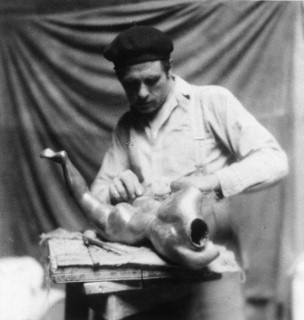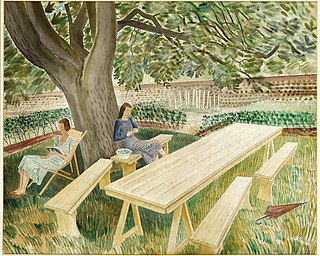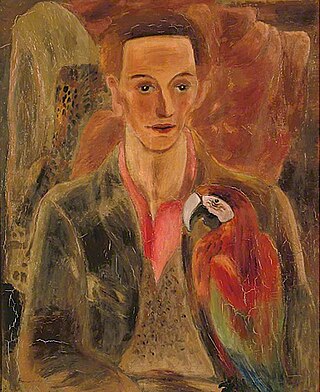
Colchester is a city in northeastern Essex, England. It is the second-largest settlement in the county, with a population of 130,245 at the 2021 Census. The demonym is Colcestrian.

George Claude Leon Underwood was a British artist, although primarily known as a sculptor, printmaker and painter, he was also an influential teacher and promotor of African art. His travels in Mexico and West Africa had a substantial influence on his art, particularly on the representation of the human figure in his sculptures and paintings. Underwood is best known for his sculptures cast in bronze, carvings in marble, stone and wood and his drawings. His lifetime's work includes a wide range of media and activities, with an expressive and technical mastery. Underwood did not hold modernism and abstraction in art in high regard and this led to critics often ignoring his work until the 1960s when he came to be viewed as an important figure in the development of modern sculpture in Britain.

Eric William Ravilious was a British painter, designer, book illustrator and wood-engraver. He grew up in Sussex, and is particularly known for his watercolours of the South Downs, Castle Hedingham and other English landscapes, which examine English landscape and vernacular art with an off-kilter, modernist sensibility and clarity. He served as a war artist, and was the first British war artist to die on active service in World War II when the aircraft he was in was lost off Iceland.
John Northcote Nash was a British painter of landscapes and still-lives, and a wood engraver and illustrator, particularly of botanic works. He was the younger brother of the artist Paul Nash.

Sir Cedric Lockwood Morris, 9th Baronet was a British artist, art teacher and plantsman. He was born in Swansea in South Wales, but worked mainly in East Anglia. As an artist he is best known for his portraits, flower paintings and landscapes.
David Miles Bensusan-Butt was an English economist who spent much of his career in Australia. Known as David, he published his work as D. M. Bensusan-Butt.

Lucien Pissarro was a French landscape painter, printmaker, wood engraver, designer, and printer of fine books. His landscape paintings employ techniques of Impressionism and Neo-Impressionism, but he also exhibited with Les XX. Apart from his landscapes, he painted a few still lifes and family portraits. Until 1890 he worked in France, but thereafter was based in Great Britain. He was the oldest son of the French Impressionist painter Camille Pissarro and his wife Julie.

Robert Alexander Polhill Bevan CBE was a significant figure in British communications and advertising during the mid-20th century. He was the second child of the artists Robert Polhill Bevan and Stanisława de Karłowska and was born at the Bevan house, Horsgate, in Cuckfield, Sussex.

Robert Priseman is a British artist, collector, writer, curator and publisher who lives and works in Essex, England. Over 200 works of art by Priseman are held in art museum collections around the world including the V&A, Museum der Moderne Salzburg, Art Gallery of New South Wales, Musée de Louvain la Neuve, The Royal Collection at Windsor Castle, The Allen Memorial Art Museum, The Mead Art Museum, Honolulu Museum of Art and The National Galleries of Scotland.
Nigel Graeme Henderson (1 April 1917 – 15 May 1985) was an English documentary artist, and photographer.

Firstsite is a visual arts organisation based in Colchester, Essex, which opened in 1993 as Colchester and District Visual Arts Trust, changing its name to Firstsite in 1995. Its current building was opened in 2011. It was the national Art Fund's Museum of the Year in 2021. The building Firstsite occupies as a tenant was designed by Rafael Viñoly and the freehold is retained by Colchester Council. The building is situated in Colchester's "Cultural Quarter" near The Minories, Colchester, fifteen Queen Street, the Norman Colchester Castle, the Natural History Museum, Hollytrees Museum and Colchester's Roman Wall.
Bernard Reynolds (1915–1997) was an esteemed East Anglian artist with a special interest in sculpting. He was born in Norwich and lived for almost fifty years in Ipswich. For although Reynolds is most widely known as a sculptor, he possessed the capacity to be an inspirational teacher as well as an artist, and he fulfilled both of these roles with his own particular kind of integrity. Reynolds was characterised for his quietly rigorous self-imposed discipline to every project he undertook – and due to his multiple pursuits, his projects were many and varied.
James Dodds is an East Anglian artist whose practice centers on painting, linocut and relief carving. Born in Brightlingsea, Essex, he now lives and works in Wivenhoe producing prints and books as the Jardine Press. He is the son of East Anglian artist Andrew Dodds and has been described as "boatbuilding’s artist laureate".

Henry William Collins and Joyce Millicent Pallot were two artists who lived and worked together for over 60 years. They are best known for their work on a number of large-scale public concrete murals during the 1960s and 1970s, many of which remain around the UK today. Their mural work often included elements relating to the cultural and industrial heritage of the location they were sited and is part of a tradition of muralists that includes William Mitchell and Kenneth Budd amongst others. Henry Collins and Joyce Pallot were both prominent members of the Colchester Art Society and exhibited together on a number of occasions.
Colchester Art Society was founded in 1946 by a group of artists who lived in Colchester and the nearby areas, many of whom were also linked to the Colchester School of Art, which is part of Colchester Institute. The aim of the society was and still is the promotion of the visual arts.

Simon Carter is an English artist and curator.
Dr Ruth Bensusan-Butt, née Bensusan, (1877-1957) was the first female medical doctor in Colchester.
Bay was a napped coarse woolen fabric, not technically considered cloth, introduced to England by Flemish immigrants in the 16th century. It was produced in Essex at Colchester and Bocking, and also in various towns in the West of England. Production continued until the 19th century. Bays were made into linings for furniture, hangings, curtains, bed surroundings, and cloaks.
John Gordon Bensusan-Butt was an English landscape painter and author.
Frederick Hans Haagensen was an Anglo-Norwegian visual artist and graphic artist. He often used the signature FH Haagensen. His attraction to nature and the sea can be traced back to his childhood memories of wandering the rural landscape of the estuary of the River Humber.













